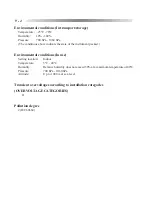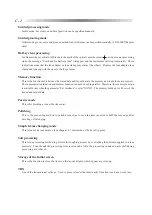
In this manual, the following terms are used to provide an easy understanding of the contents. Therefore,
thoroughly understand them before reading the contents of this manual.
Active mode
This is for blocking a lens at the optical center.
Auto processing mode
In this mode, the bevel curve and bevel position are automatically calculated by the computer to determine the
best values for processing.
Auto grooving mode
In this mode, the groove curve and groove position are automatically calculated by the computer to determine
the best values for grooving. (LE-9000EX Express only)
Bifocal mode
This mode is for laying out bifocal lenses. In this mode, a lens is blocked at 5 mm above and 5 mm outside from
the top line center of the segment with a lens cup by using a centering device.
Chamfering
This is the processing method to chamfer a lens edge of the rear surface or both surfaces before processing
is completed. (LE-9000EX Express only)
DBL (Distance Between Lenses)
This represents the distance between the nasal ends of the right and left rims.
EX lens processing mode
This mode serves to process EX lenses. In this mode, the bevel curve will set to the curve of the rear surface.
EX lens grooving mode
This mode serves to groove EX lenses for nylor frames. In this mode, the groove curve will set to the curve of
the rear surface. (LE-9000EX Express only)
Eye point layout
This is the form to input the eye points as the optical center by the distance measured from the nasal and bottom
sides of a lens outline. This form serves to specify the position of the eye point, which is marked on the dummy
lenses, as the optical center.
FPD (Frame Pupillary Distance)
This represents the distance between the right and left
rim centers. The rim centers are calculated by the boxing
system.
APPENDIX C
GLOSSARY
DBL
FPD
Summary of Contents for LE-9000DX Express
Page 1: ...NIDEK PATTERNLESS EDGER LE 9000EX Express LE 9000DX Express OPERATOR SMANUAL...
Page 17: ...2 9 or or Top view...
Page 19: ...2 11...
Page 153: ......

























